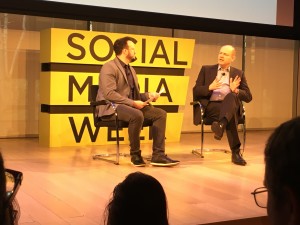… and other things I learned about Virtual Reality (VR) at last week’s Social Media Week New York:
Virtual Reality is the Future of Computing
Michelle Klein, head of North American business marketing at Facebook, said there’s a new revolution in computing every 10 to 15 years. VR is not a medium. It’s the future of computing. Klein also believes VR is “the last screen”.
Jessica Brillhart, principal VR filmmaker for Google, disagreed about VR being the last screen, saying, “Artificial intelligence is doing really interesting things”.
Google Cardboard is the gateway to VR
Brillhart acknowledged we’re still on the use curve for VR, and felt the New York Times and Google Cardboard partnership was “the best on-ramp for a lot of people”.
Klein is particularly interested in seeing how the hardware (read: Facebook’s bet on Oculus Rift) evolves to make VR more mainstream.
Sam Dolnick, associate editor at the New York Times responsible for VR content and the Google deal, said his team asked themselves, “What about the next time when we don’t put Cardboard on their stoop?” He called Cardboard the ”magic ticket” to the VR experience and predicted everyone will have a VR headset sitting in their living rooms.
The group talked about how the smart phone deserves the props for making VR an actual reality for the mainstream. Earlier this week, we saw that in Sweden McDonald’s Happy Meal containers turn into VR goggles.

VR demands the right social moment
Dolnick said it’s important to ask yourself why you’re choosing VR over video. If you don’t have a good answer, maybe you haven’t hit on the right VR idea.
Trevor Guthrie, founder of marketing firm Giant Spoon, said you have to find the right social moment for your brand and then think of how someone gets “folded into that moment”.
Sydney Ray Levin, who is the executive producer for T Brand Studios at the New York Times, said it’s important to understand what VR leaves behind. “It’s not linear. It’s a passive experience that becomes active. It’s an honor to take over someone’s senses. We have to tell a story that becomes a memory.”
Katrina Craigwell, director of global content and programming at General Electric, shared her experience creating sponsored VR content with the New York Times. She described it as “creating worlds where people have control vs. linear storytelling”. Before you scoff at the blurring of the line, you should know the GE VR performed better than some editorial VR.
We are just scratching the surface on VR
Klein said she could envision using VR to test drive a car. She’s also excited about opportunities in education and medicine. Facebook is “just getting started” on VR ads. “The consumer experience is most important, monetization happens later.”
Craigwell’s campaign told a story about the seemingly complex Industrial Internet – a “second layer of the Internet of Things”. “We live by machinery. It’s important to keep opening the doors around the humanity of it.” Her advice was to read science fiction (namely Snow Crash and Ready Player One) since “that community has been thinking about VR for a long time”.
Dolnick said every desk in the newsroom wants to tell their VR story and they have a “bunch” of journalistic VR films coming out through their app. He’s interested in the “communal viewing” potential of breaking news events covered in VR. The vigils held after the Paris attacks was their first attempt.
Guthrie cautioned the audience about putting their VR stakes in the ground too early. He thinks we’ll eventually see “live” VR.
Is VR on your radar? We’d love to hear about your experiences.
